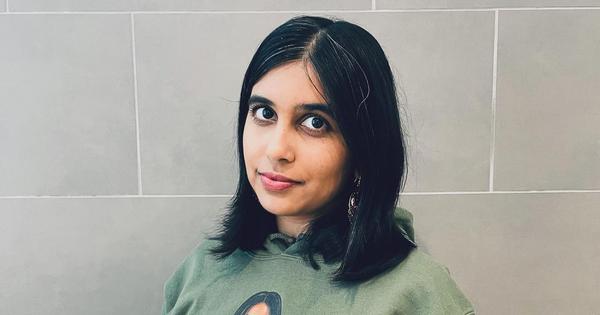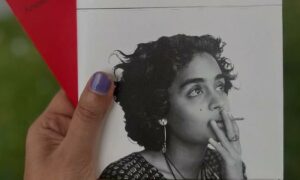
I learned how to hope at nineteen.
It started with a song. I did not, could not, know what was to come – the blood that would stain the streets, the fire that would fill the skies, the scars that would carve our souls – but even if I had, still I would have chosen it. Still I would have set myself on the path of rebellion.
On a windy March day in 1962, I pulled on my best and newest frock, a long navy-blue gown that Aai and I had commissioned from the local tailor. The high-waisted bust loosened into draped pleats, embroidered with silver sequins, and the sleeves went down to my elbows, pretty and modest. British styles often took some years to come to India, so the trend here had probably already gone out of fashion on their island. But I could not wear anything else, for saris or lehengas were not considered formal enough for British events.
The pointed heels were my least favourite part of the outfit, as they looked painful and felt worse. But Aai had insisted on buying them for my “promising career,” and so I reluctantly slipped on the heels and staggered out of the flat. No matter what the British had done to my Baba, Aai was proud that I had been selected as one of the token students attending the chancellor’s annual education night, a glittery affair meant to help philanthropists and educators feel better about the British project in India.
I had not told her my plan for the night. She would not have approved.
The headmaster had given me fare for a rickshaw, so I flagged one down and directed the driver to go to City Hall. He looked surprised but did not question it. After all, it was over an hour’s ride from our neighbourhood in Kingston, the Indian section covering the north of Salsette Island, to Old Bombay, the British peninsula of Salsette that had once been the southern tip of the Seven Islands. He would earn a good fare.
As we travelled toward southern Kingston, the homes became progressively nicer, the streets cleaner, the shops pricier. Here, the richest Indians could own their land – or at least rent it in ninety-nine-year terms from the British, who were the true owners of the isle. I passed by my school, which was twenty minutes by rickshaw but over an hour by the chain of buses and walking I usually undertook. Without fanfare, we crossed the invisible dividing line into Bombay. It was the first time in my memory I had left Kingston. The fare to Bombay was out of the question, and there was no reason to go anyway. I was almost disappointed, at first, for the homes here looked worse than the homes in Kingston. They were small, crowded, dilapidated.
But the deeper we travelled into Bombay, the nicer things got, and I realised – just as the richest Indians lived next to the British, the poorest British lived next to the Indians. As the buildings became more ornate, the clothes changed too; suddenly it appeared that every man was wearing a suit. People were out and about, not preparing for a curfew that discouraged leaving home after work for fear of getting caught outside after hours. I leaned my head out of the window to observe, glad that it was still March, before the muggy heat enveloped the city and melted even the tar on the roads. So this was how the British lived. The raucous colours of Kingston were nowhere to be seen, replaced by an unrelenting grey dullness.
As we approached downtown, the rickshawala asked, “Madam, can you spare ten more minutes?”
“Why? Is there a disturbance up ahead?”
“Nothing like that. I want to take an alternate route,” he said.
“No extra charge.”
I had left early, so I figured it didn’t matter much. “Yes, whatever way you think is best.”
“This is best,” he assured me. We drove for a little while longer, rounded the curve, and—
“Queen’s Necklace,” the rickshawala declared proudly.
I gasped before I could stop myself. We stood at one end of Back Bay, the southernmost bay of Salsette. In the setting sun, an arc of streetlights connected us to the other side of the bay in an unbroken chain of golden pearls, more striking than I had ever imagined. The Old Bombay skyline stretched ahead of us, and with it, the promise of this city.
He drove us down Marine Drive. For a moment we too were a part of the Queen’s Necklace, the blurred, ever-moving lights that formed the string connecting each pearl. My lips stretched into a smile, but my shoulders tensed. The contradiction of it all – the British lights creating true splendour– made my head hurt.
Finally, we reached my destination. City Hall was beautiful. Far more beautiful than I had expected, and far more beautiful than it deserved to be. A century ago, just after the Sepoy Mutiny, Indian labourers built this palace out of marble, with columns of white and grey adorning the outside. The steps leading up to the doors were nearly pristine, despite the fact that the city never was. It appeared as though every light in the building was on. I supposed electricity rations wouldn’t apply to those doing the rationing.
For the first time, I doubted my plan.
I had wanted to refuse the headmaster’s invitation. What kind of daughter was I, to kiss the boots of those who drove my Baba from my home? It had been over a decade since I last saw him, and my memories of him were fraying at the edges. But when I told my mother, she said, “Of course you will go!” Then she hugged me tight and whispered, “Do you think they don’t still watch us? Do you think they do not monitor us for odd behaviour? I did not raise an idiot, Kalki. We must not do anything to raise their suspicions. You cannot refuse their invitation.” She made a good point, and I hated it
Excerpted with permission from Ten Incarnations of Rebellion, Vaishnavi Patel, Penguin India.
This article first appeared on Scroll.in
📰 Crime Today News is proudly sponsored by DRYFRUIT & CO – A Brand by eFabby Global LLC
Design & Developed by Yes Mom Hosting






